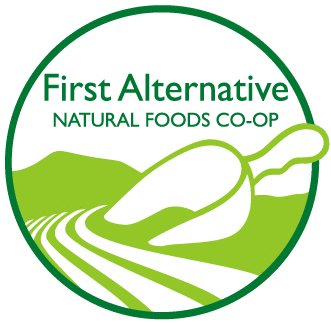Owners: David Landis and Anita Azarenko
Crew size: one full-time and up to 6 part-time
Acreage farmed: 160
Years in operation: 45 years of beef cattle; 22 years in fruit and hazelnuts
 La Mancha Ranch and Orchard grows certified organic apples, cherries, peaches, apricots, pears, table grapes, asparagus, plums and hazelnuts. They also raise non-certified pasture-raised, grass-fed beef.
La Mancha Ranch and Orchard grows certified organic apples, cherries, peaches, apricots, pears, table grapes, asparagus, plums and hazelnuts. They also raise non-certified pasture-raised, grass-fed beef.
Here at the Co-op, we’ve been buying great stuff from La Mancha for 18 years, including apples, hazelnuts, and sometimes their cherries, peaches, table grapes and, when we’re lucky, their exquisite apple cider. We recently caught up with Anita and David and asked them a couple of questions about their operation. Here’s what they had to say:
Our farming values embrace a local, safe and resilient food system that has nurturing and nature at its core. We aspire to teach our community about healthy whole foods and the joys and challenges associated with growing organically grown fruit and hazelnuts.
David moved to La Mancha Ranch in 1968 when his dad purchased a quarter section (160 acres) ranch north of Sweet Home in the beautiful foothills of the Cascades. The family raised cattle, sheep and timber. David assumed full responsibility of the farm in 1978 after his father passed away. In 1993 David and Anita were married. Anita was trained professionally and hired at Oregon State University to do research, teaching and outreach as a horticulturist with an emphasis on tree fruit and hazelnuts. She had always dreamed of the opportunity to farm and now she’s married to a farmer!
The first foray into growing fruit started with planting an acre of semi-dwarf Liberty apple trees. We decided to raise fruit organically since we wanted to learn to work and challenge ourselves to think and manage our farming system ecologically. We wanted to limit exposure of our community, employees, family members, and ourselves to synthetic pesticides.
We now grow fruit and hazelnuts on about 15 acres of land, organically.
Because of the lack of ground water in our area (about 10% of what many commercial growers have available to them), we manage the amount of water applied by using drip irrigation and increasing soil organic matter to retain water. The manure from our cattle is composted and applied to the orchards.
We encourage beneficial insects and birds by planting flowering perennial hedges and setting up numerous bird houses. Integrated pest management is implemented to predict appropriate insect management strategies. Netting that covers an acre of land (basically, the size of a football field minus the end zones) discourages birds from eating cherries.
We are now focusing on the “right plant, right place” principle in terms of variety selection of our fruit crops. We have decided to change the types of apple and pear varieties that we grow to avoid having to manage for apple scab and fireblight diseases. Plantings are being removed to plant only disease resistant varieties. Late ripening cherries are planted to try to avoid rain cracking. A couple of tunnels have been erected under which we grow apricots, early ripening cherries and table grapes to increase fruit set and reduce losses to rain. Since most tree fruit ripen towards the end of summer, we are continuously striving for ways to extend our harvest season on both ends, earlier and later. One can imagine the additional challenge of predicting the best varieties to grow since perennial fruit and hazelnut trees take 3-6 years to begin producing commercial yields.
People often ask why do we do this? There are long hours for at least 9 months of the year; constant change and adaptation; uncontrollable weather challenges like frost, hail, poorly timed rains, and wind; equipment failure; etc. We have learned that what we do is not just about growing fruit, it’s about how whole foods restore and are vital to the well-being of people and places. When children return to us as adults with fond stories of pie-making with mom and dad, cider pressing, field trips, and are now buying the fruit, we are inspired to keep growing. Seeing young children light up when they bite into a crunchy, juicy apple; eaters having the juice of peaches run down their faces; nutophiles opening a bag of our roasted hazelnuts and sighing with contentment from the natural aromas, brings a renewed commitment to farm for another season. Being able to witness and participate in the creation of the food that sustains us and landscapes that provide beauty, clean water, the air that we breathe, and places for spiritual growth, is a gift to us that we want to share.

